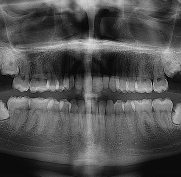
Breaking news: A survey of 289 UK surgeons, led by Mr Geoff Chiu and conducted by Saving Faces and British Association of Oral and Maxillofacial Surgeons (BAOMS) through their partnership in the National Facial Oral and Oculoplastic Centre (NFORC), illustrates the uncertainty over the best way to treat wisdom tooth infection and recommends further research. The results are now published in the British Journal of Oral and Maxillofacial Surgery.
When there is no room in the jaw for a wisdom tooth to grow normally, it usually emerges at an angle or gets stuck. These impacted wisdom teeth often become infected, damage adjacent teeth or cause other dental problems. As many of you probably know, these wisdom tooth problems are often very painful for the patient. Sometimes X-rays and scans show that the root of the infected tooth is very close to a nerve and needs to be treated with extra care, as there is a risk of permanent lip numbness if the nerve is damaged during the procedure. These are high-risk cases.
At least two vastly different methods can be recommended for the same patient depending on the surgeon they see.
The surgeon could take out the entire tooth including its roots. This is known as complete surgical removal. An alternative operation called coronectomy is available for the 1 in 5 patients who are at risk of nerve damage. This involves removing the visible part of the tooth while leaving the roots in the gum.
The publication concludes that coronectomy may prevent permanent nerve damage in high-risk cases, however there is a gap in evidence and knowledge to support coronectomy. This shows uncertainty over the best way to treat high-risk cases. As a result, further studies are needed to determine the effectiveness and safety of coronectomy.
Fortunately, NFORC is on the case. In partnership with Mr Geoff Chiu, Consultant Oral and Maxillofacial Surgeon and Professor Paul Coulthard, Dean for Dentistry and Director at the Barts and The London School of Medicine & Dentistry, we will be carrying out further research on 4,000 patients to find out which procedure (complete surgical removal or coronectomy) benefits patients more and which have more complications.
We would like to thank Ahmed Omran, who first proposed the research, Geoff Chiu, Amrita Bose, Roberta Maroni (our very helpful statistician), Jagtar Dhanda, Douglas Hammond, Clare Moynihan, Antonio Ciniglio and the reviewers who have dedicated their time and efforts for the successful publication of this paper.
